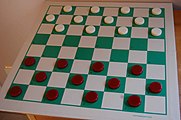
A checkerboard (North American English) or chequerboard (Commonwealth English except Canada; see spelling differences) is a game board of checkered pattern on which checkers (also known as English draughts) is played. Most commonly, it consists of 64 squares (8×8) of alternating dark and light color, typically green and buff (official tournaments), black and red (consumer commercial), or black and white (printed diagrams). An 8×8 checkerboard is used to play many other games, including chess, whereby it is known as a chessboard. Other rectangular square-tiled boards are also often called checkerboards. In The Netherlands, however, a dambord (checker board) has 10 rows and 10 columns for 100 squares in total (see article International draughts).
Games and puzzles using checkerboards

Martin Gardner featured puzzles based on checkerboards in his November 1962 Mathematical Games column in Scientific American. A square checkerboard with an alternating pattern is used for games including:
- Amazons
- Chapayev
- Chess and some of its variants (see chessboard)
- Czech draughts
- Draughts, also known as checkers
- Fox games
- Frisian draughts
- Gounki
- International draughts
- Italian draughts
- Lines of Action
- Pool checkers
- Russian checkers
The following games require an 8×8 board and are sometimes played on a chessboard.
Mathematical description
Given a grid with rows and columns, a function ,
or, alternatively,
The element is black and represents the lower left corner of the board.
Gallery
-
 An empty 8×8 checkerboard
An empty 8×8 checkerboard
-
 An empty 8×8 checkerboard diagram
An empty 8×8 checkerboard diagram
-
 The opening setup of international draughts, which uses a 10×10 checkerboard
The opening setup of international draughts, which uses a 10×10 checkerboard
-
 English draughts tournament standard
English draughts tournament standard
See also
References
- Weisstein, Eric W. "Checkerboard". mathworld.wolfram.com.
 rows and
rows and  columns, a function
columns, a function  ,
,


 is black and represents the lower left corner of the board.
is black and represents the lower left corner of the board.